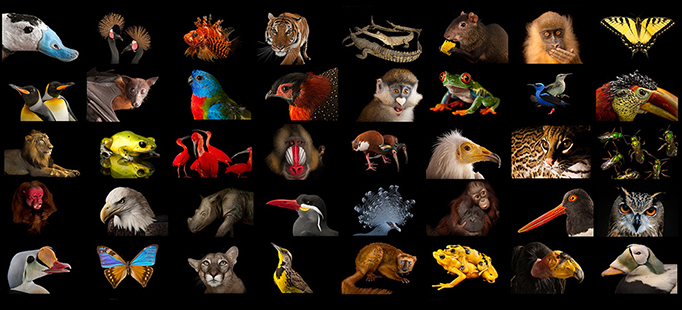 Using the power of photography to inspire people to save animals before it’s too late, in an Australian first, Melbourne Zoo’s Leopard Lodge is currently playing host to the National Geographic Photo Ark, showcasing the work of photographer Joel Sartore.
Using the power of photography to inspire people to save animals before it’s too late, in an Australian first, Melbourne Zoo’s Leopard Lodge is currently playing host to the National Geographic Photo Ark, showcasing the work of photographer Joel Sartore.
For many of Earth’s creatures, time is running out. Species are disappearing at an alarming rate. The National Geographic Photo Ark is pursuing the ambitious goal of photographing every species in the world’s zoos and wildlife sanctuaries, to inspire action through education, and help save wildlife by supporting on-the-ground conservation projects.
In what will be the largest single archive of studio-quality photographs of biodiversity ever, Sartore estimates that when completed, the Photo Ark will include portraits of more than 12,000 species representing several animal classes, including birds, fish, mammals, reptiles, amphibians and invertebrates. These iconic portraits have captured the imagination of people around the world and have even been projected on the Empire State Building in New York City and St. Peter’s Basilica in Rome.
To date he has worked in more than 250 zoos, aquariums and animal rescue centers around the world, visiting more than 40 countries and completing studio portraits of more than 6,000 species, most photographed on either a plain black or white background. No matter its size, each animal is treated with the same amount of affection and respect.
The results are portraits that are not just stunningly beautiful, but also intimate and moving. “It’s the eye contact that moves people,” Sartore says of the animals’ expressions. “It engages … feelings of compassion and a desire to help.”
In addition to creating an archival record for generations to come, this project is a hopeful platform for conservation and shines a light on individuals and organisations working to preserve species around the world. Serving as an important record of these animals’ existence and a powerful testament to the importance of saving them.
It is very fitting for the Photo Ark exhibition to be held in Melbourne. Many of the images featured were taken at Melbourne Zoo and Healesville Sanctuary and the local species featured are part of Zoos Victoria’s Fighting Extinction list of critically threatened species native to south-eastern Australia. These local Australian species are just some of the animals of more than 50 of Sartore’s most compelling images in a haunting collection of the world’s rare and unique animals.
“Joel Sartore portrays these precious species in such a captivating way, it’s hard not to be moved by his portraits,” says Jenny Gray, Zoos Victoria CEO. “Some of the species featured are virtually unknown and it’s such a brilliant way to connect zoo visitors and people around the world to conservation, especially the type of conservation happening in zoos all over the world.”
“Without zoos, some of these species would not exist and we’re just so lucky that someone like Joel has managed to capture their beauty before it’s too late. Now the rest is up to us. It’s up to you and me to do something about it.”
Joel Sartore is a photographer, speaker, author, teacher, and a 25-year contributor to National Geographic magazine as well as Audubon, Geo, Time, Life, Newsweek, and Sports Illustrated. He has written several books including National Geographic’s Rare: Portraits of America’s Endangered Species, Photographing Your Family, and Let’s Be Reasonable – a collection of essays from the CBS Sunday Morning show.
Sartore and his work have been the subjects of several national broadcasts, including the National Geographic Channel’s Explorer, the NBC Nightly News, NPR’s Weekend Edition, and an hour-long PBS documentary, At Close Range. He is also a contributor on the CBS Sunday Morning Show with Charles Osgood.
National Geographic Photo Ark
Leopard Lodge – Melbourne Zoo, Elliott Avenue, Parkville
Exhibition continues to 1 October 2017
Free admission (after zoo entry)
For more information, visit: www.zoo.org.au for details.
Image: A composite photograph of mammals, insects, reptiles, crustaceans, birds and fish from the National Geographic Photo Ark – by Joel Sartore
